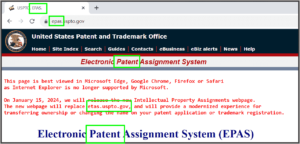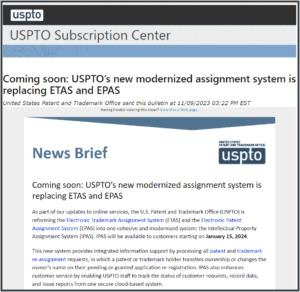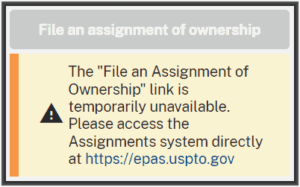
(Update: the migration has now been postponed for a third time, see blog article.)
On October 31, 2023, the USPTO announced that December 4, 2023 was the date upon which a new system called IPAS (Intellectual Property Assignment System) will replace EPAS (Electronic Patent Assignment System) and ETAS (Electronic Trademark Assignment System). See screen shot at right. But now the release date has been pushed back. One wonders whether IPAS will disappoint its users, as will be discussed.

The banner across the top of the EPAS (Electronic Patent Assignment System) has been quietly altered so that it now gives a new date of January 15, 2024 as the date that IPAS will replace … ETAS. (Note that the banner does not say that IPAS will replace EPAS in addition to replacing ETAS.) The new launch date of January 15, 2024 is six weeks later than the original launch date of December 4, 2023.

The USPTO has also posted a “News Brief” (USPTO link, archived at right) clarifying that indeed IPAS will not only replace ETAS but will also replace EPAS.
The USPTO’s plan to shut down EPAS and ETAS, succeeding those systems with IPAS, seems likely to be the explanation for a bug in Patent Center that was first reported on March 28, 2023 as CP128:
When you are on the ack receipt page, you see an orange box at right that says:
The “file an assignment of ownership” link is temporarily broken.
(This link on the Patent Center ack receipt page had, by March of 2023, been “temporarily broken” for some six months.)

This orange box, which has been visible on the Patent Center ack receipt page for more than a year now, has recently been revised to say that the link is “temporarily unavailable” rather than “temporarily broken”, and now offers a link to EPAS. This makes clear that whatever “File an Assignment of Ownership” means, it is not the same thing as EPAS. It thus seems that the “File an Assignment of Ownership” system that had been alluded to in this orange box since September of 2022 is the newly named “Intellectual Property Assignment System”.
Users have been puzzled why this discussion of the “File an Assignment of Ownership” system has, for the past year, appeared in Patent Center only on the ack receipt page and not anywhere else in the Patent Center user interface.
The two things that the reader learns about this new IPAS system from the News Brief are that it will be “cohesive” and “modernized”. While it is of course very helpful to learn that IPAS will be “cohesive” and “modernized”, conspicuously absent from the News Brief (and from any of USPTO’s earlier communications about IPAS) is any hint or suggestion of any of the following:
-
- any effort to ask users what features they are looking for in the IPAS system;
- any effort to ask users what, if anything, was wrong about EPAS or ETAS and that needed fixing;
- any commitment to ensuring that all of the functionalities of the EPAS/ETAS systems will be carried forward into the IPAS system;
- any indication that alpha or beta testing of IPAS by actual users ever took place;
- any indication of planning for a beta testing effort between now and launch day;
- any commitment that the legacy systems would remain in operation for some amount of time after the launch of the IPAS system, to permit continued use of the legacy systems if against all odds there turns out to be some defect in the newly launched IPAS system;
- any presentation (for example with screen shots or mock-ups) that shows what the IPAS is going to look like.
Meaningful preview. One of the most glaring failures in EFS-Web, from its launch in 2002 to the present, is the “preview” function that supposedly allows the user to preview an uploaded PDF document to see what it will look like after the user clicks “submit”. In EFS-Web, the promised “preview” is nothing of the sort — instead, if one clicks “preview”, the EFS-Web system merely hands back to the user the exact same PDF file that the user had uploaded moments earlier. This tells the user nothing more than what the user could have learned simply clicking on the PDF file on the user’s own computer drive prior to doing the upload.
In EFS-Web, any uploaded PDF risks being “halftoned”, and if it gets halftoned, it may end up being fuzzy or illegible. But the so-called “preview” in EFS-Web does not actually preview the halftoned document.
WIPO launched its ePCT system in 2013. From its first day in service, the ePCT system offered a true “preview”. The user could click “preview” and what would appear on the screen is a faithful preview of what would actually go into the system if the user were to click “submit”. This permitted the user to consider whether the halftoning, if any, would harm the legibility of the document to an unacceptable extent. The user could, if necessary, back off from the submission and could work with the source document to remedy the problem. (Oppedahl Patent Law Firm LLC was the first entity, anywhere in the world, to e-file a PCT application in the then-new ePCT system. Blog article.)
The designer of EPAS/ETAS got it right with its preview. If a user uploads a document to be recorded, EPAS/ETAS offers a true preview, showing what the uploaded document really would look like (with halftoning, if any) if the user were to click “submit”.
When the USPTO announced the alpha testing in 2018 of its then-new Patent Center system, users begged the USPTO to follow the example of EPAS and ETAS and ePCT, and to avoid the defect in EFS-Web, in providing its “preview” function. One of many disappointments with Patent Center is that when Patent Center was first revealed to its alpha testers, its “preview” was exactly as defective as the “preview” in the previous EFS-Web system. Even now, after five years of further beta testing of Patent Center, the “preview” continues to be defective, merely handing back to the user the exact same PDF file that the user had uploaded moments earlier.
This raises the question of whether IPAS will have a defective “preview”, following in the footsteps of EFS-Web and Patent Center, or whether it will have a true preview, taking the examples of EPAS and ETAS and ePCT.
PCT application numbers. As mentioned above, the USPTO has not asked the patent filing community anything about what the patent filing community might want in this new IPAS system, and has not asked the patent filing community anything about what, if, anything, is wanting about EPAS or ETAS and might need fixing in IPAS.
One of the defects in EPAS is that it fails to accept properly formatted PCT application numbers. Instead, the user is only able to proceed by typing in a portion of the PCT application number. For example if the PCT application number is PCT/US2022/012345, the user is not permitted to actually type in this PCT application number in EPAS. Instead the user needs to somehow already know that what the user must type in is “US2212345”. This secret alternative format is not indicated by any example on the screen where the “portion” might be explained. One can learn of the needed format only by clicking on a link that brings up a ten-page document, on the seventh page of which is the answer to this question.
One hopes that in IPAS, the user will be permitted to type in the actual correctly formatted PCT application number such as PCT/US2022/012345.
Hague Agreement application numbers. The same would be the case for a Hague Agreement application number. The user ought to be able to type in the actual correctly formatted Hague Agreement application number such as DM/123456.
Next steps for the USPTO. This brings us back around to the slippage of six weeks, unexplained by the USPTO, in the planned launch date of the new IPAS system, namely from December 4, 2023 to January 15, 2024. One hopes that this newfound extra six weeks in the rollout process will permit the USPTO to do the right things:
-
- get in touch with actual users to provide a beta testing opportunity;
- get in touch with actual users to find out if there are things wrong with EPAS/ETAS that need fixing in IPAS;
- get in touch with actual users to find out what actual users would like to see in IPAS.
There is no doubt that the members of the Patent Center listserv and the members of the e-Trademarks listserv would be willing, and indeed eager, to assist the USPTO with these three things.

So the PTO isn’t admitting that it’s delayed IPAS, much less giving a reason for doing so. “Oceania had always been at war with Eastasia.”
I can’t stand the liars at the USPTO, and my dislike for them grows more and more every day.
Every week I get emails about new programs run by the PTO that have nothing to do with patents.
How about just doing your job, and when it comes to software development, working with those of us use the software to make sure you get it right? And understanding that that’s an iterative process?